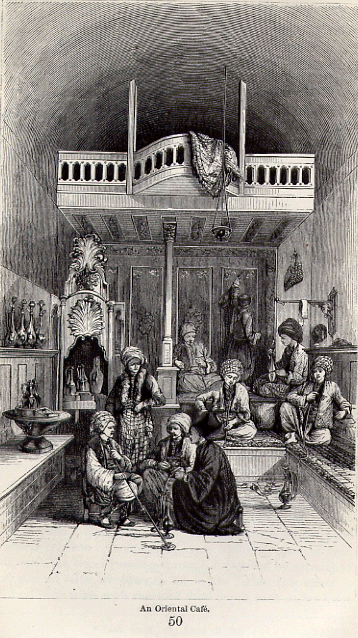
“An Oriental Café” from Bible Lands by Henry Van-Lennep, 1875, p. 779
For those who share the tactile thrill of fingers thumbing through brown-edged paper and caressing delicate bindings of century-plus-old books, I dedicate a new theme on Tabsir devoted to the art of lithographic representation of the Middle East. Lithographica Arabica — long live the line drawings and antiquated woodcuts of bibliophilic bliss.
The café (more properly kahweh) is a nearer approach to Western ideas, and deserves a passing notice, being an important institution of the East. It consists of a room furnished with benches fixed in the walls and a few low stools. In one corner, on a raised fire-place, coffee is ever simmering in a copper pot. Long wooden pipes are set horizontally upon a rack on the wall, and smoking bottles (argileh) stand in a row upon a shelf. This is the general place of resort for the men: women are excluded. Here on his way to his business or his shop, every man takes his morning sip of coffee, and fills a pipe with his own tobacco, from a bag which he takes from his bosom. It costs him just half a cent. Here friends meet by appointment, to have a chat. this, too, is the Bourse of the town, where merchants gather to transact business; and here, outside of the door, the workmen who seek employment often sit on little stools, or upon the ground, waiting to be hired for a day’s work in the vineyard of the field. Within the coffee-shop there is sometimes a gallery, accessible by a narrow staircase, whither guests may retire and order refreshments, or even a full meal from a cooking establishment in the neighborhood, or from a passing mohalebijh. The café has spread far and wide throughout the East. It not only takes its place among the other shops of the town as part and parcel of the system of business and commercial transactions, but even encroaches upon the quarters set apart for family residences; it particularly selects the most picturesque sites, especially such as combine the beauties of nature with the ever-varying movements of a sea-port or a thoroughfare. Such a spot is the paradise of the Oriental, where he dreams and builds castles in the air, under the inspiration of his favorite narcotics, coffee and tobacco, enhanced, perhaps, by the dreamy thrumming of the mandolin or saz, accompanied by a plaintive Oriental air. The café may also be found upon the high-road, offering a momentary refreshment to the weary traveler, or affording him a resting-place for the night.
Excerpt from Rev. Henry J. Van-Lennep, Bible Lands: Their Modern Customs and Manners Illustrative of Scripture with maps and woodcuts. New York: Harper & Brothers, 1875, pp. 777-778.
For Lithographica Arabica 1, click here.